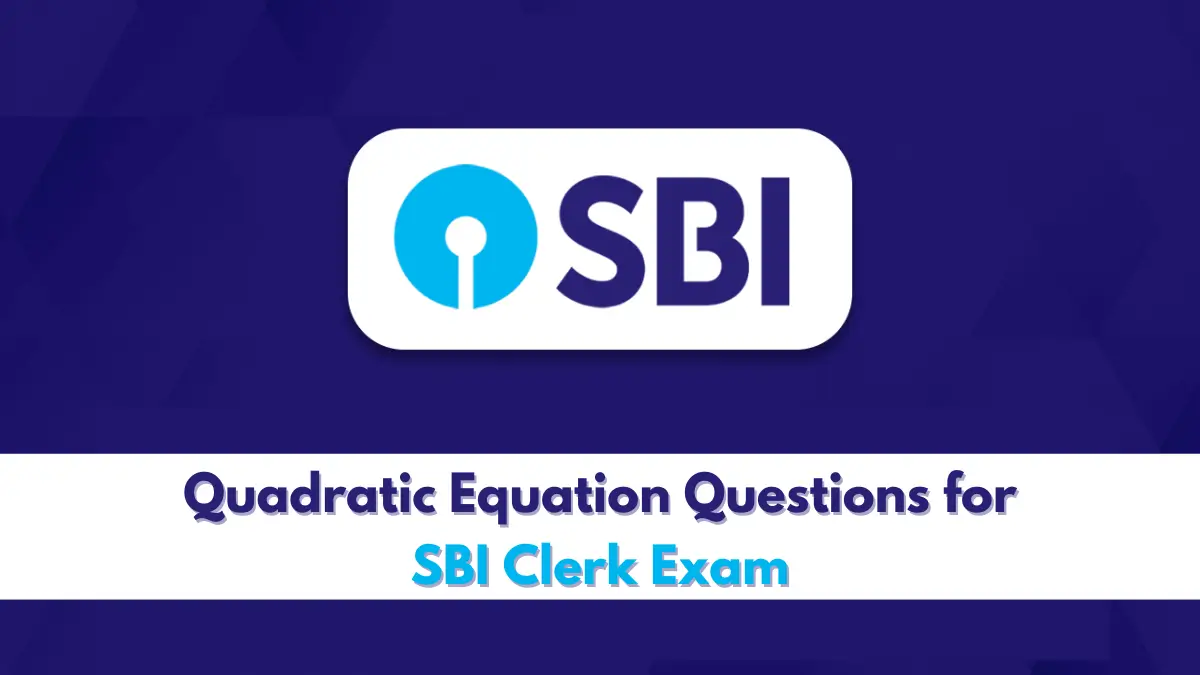The Quadratic Equation is one of the most scoring topics in the Quantitative Aptitude section of the SBI Clerk Exam. Questions from this chapter are usually straightforward, requiring good calculation speed and conceptual clarity. Practising these regularly helps candidates save time during the exam. With consistent preparation, aspirants can easily boost their accuracy and overall score in the prelims exam.
Quadratic Equation for SBI Clerk Exam
In the SBI Clerk Exam, the Quadratic Equation is a crucial part of the Quantitative Aptitude section in the SBI Clerk exam, with 5 questions typically included out of the total 35 questions. These questions usually appear in the form of comparing two equations and identifying the correct relationship between their roots. These problems test both analytical thinking and calculation efficiency.
Quadratic Equation Questions for SBI Clerk Exam
Candidates who master shortcut methods and practice a wide range of variations can solve them quickly and accurately. Regular practice not only improves speed but also reduces the chances of confusion during the exam.
Directions (21-25): In each of these questions, two equations (I) and (II) are given. You have to solve both the equations and give answer.
(a) if x>y
(b) if xy
(c) if x<y
(d) if x y
(e) if x = y or no relation can be established between x and y.
Q21. (I) 8x²–10x+3=0
(II) 5y²+14y–3=0
Q22. (I) 3x²+13x+12=0
(II) y²+9y+20=0
Q23. (I) x²–4x–5=0
(II)7y²–25y–12=0
Q24. (I) x³=216
(II)2y²–25y+78=0
Q25. (I) 5x² + 31x + 48 = 0
(II) 3y² + 27y + 42 = 0
Directions (26-30): In each of these questions, two equations (I) and (II) are given. You have to solve both the equations and give answer
(a) if x>y
(b) if xy
(c) if x<y
(d) if x y
(e) if x = y or no relation can be established between x and y
Q26. I. (x-2)²-4=0
II. y²+1-2y=0
Q27. I. 3x+2y=5
II. 4x+6y=10
Q28. I. 9x² – 54x + 77 = 0
II. 12y² – 55y + 63 = 0
Q29. I. (x – 1) ² = 121
II. y² – 24y + 144 = 0
Q30.I. 7x² – 23x + 6 = 0
II. y² – 7y + 12 = 0
Directions (31-35): In each of these questions, two equations (I) and (II) are given. Solve the equations and mark the correct option:
(a) if x>y
(b) if xy
(c) if x<y
(d) if x y
(e) if x = y or no relation can be established between x and y.
Q31. I. x² + x – 12 = 0
II. y² – 9y + 14 = 0
Q32. I. 6x² + 5x + 1 = 0
II. 4y² – 15y = 4
Q33. I. 3x² + x – 2 = 0
II. 12y² + 7y + 1 = 0
Q34. I. x²+13x+42=0
II. y²+8y+12=0
Q35. I. 1=1x(2-1/136x)
II. 14y/3+9/y=13
Directions (36-40): In each of these questions, two equation (I) and (II) are given. You have to solve both the equations and give answer
(a) If x>y
(b) If xy
(c) If x<y
(d) If xy
(e) If x = y or no relation can be established between x and y
Q36. I. 2x² – 31x + 84 = 0
II. 3y² + y – 2 = 0
Q37. I. x² – 30x + 216 = 0
II. y² – 21y + 108 = 0
Q38. I. x² – 8x + 15 = 0
II. y² – 11y + 30 = 0
Q39. I. 3x²-13x+14=0
II. 2y²-17y+33=0
Q40. I. x² + 11x + 28 = 0
II. y² – 22y + 105 = 0
| Answers | |||||||||
| 01 | 02 | 03 | 04 | 05 | 06 | 07 | 08 | 09 | 10 |
| d | e | a | d | a | c | e | e | d | a |
| 11 | 12 | 13 | 14 | 15 | 16 | 17 | 18 | 19 | 20 |
| d | c | a | e | e | e | e | c | b | d |
| 21 | 22 | 23 | 24 | 25 | 26 | 27 | 28 | 29 | 30 |
| a | a | e | d | e | e | e | b | d | d |
| 31 | 32 | 33 | 34 | 35 | 36 | 37 | 38 | 39 | 40 |
| e | c | e | d | e | a | b | d | c | c |
Solutions
S1. Ans.(d)
Sol.
I. 2x² – 17x+ 36 = 0
2x² – 8x – 9x + 36 = 0
2x (x – 4) – 9 (x – 4) = 0
(2x – 9) (x- 4) = 0
x=9/2, 4
II. 2y² – 19y + 45 = 0
2y² – 10y – 9y + 45 = 0
2y (y- 5) – 9 (y- 5) = 0
(2y- 9) (y- 5) = 0
y=9/2,5
∴ y ≥ x
S2. Ans.(e)
Sol.
I. x² – 25x + 154 = 0
x² – 14x – 11x + 154 = 0
x (x – 14) – 11 (x- 14) = 0
(x – 11) (x- 14) = 0
x = 11, 14
II. y² – 28y + 195 = 0
y² – 13y – 15y + 195 = 0
y (y- 13) – 15 (y -13) =0
(y- 13) (y – 15) = 0
y = 13, 15
∴ no relation
S3. Ans.(a)
Sol.
I. 10/x-24/x² =1
Multiplying by x² on both side
10x – 24 = x²
x² – 10x + 24 = 0
x² – 6x -4x+ 24 = 0
x(x – 6) – 4 (x- 6) = 0
(x – 4) (x- 6) = 0
x= 4, 6
II. 5/y-6/y² =1
Multiplying by y² on both side
5y – 6 = y²
y² – 5y + 6 = 0
y² – 3y – 2y + 6 = 0
y (y- 3) – 2 (y- 3) = 0
(y – 2) (y- 3) = 0
y = 2, 3
∴ x > y
S4. Ans.(d)
Sol.
I. 3x² – 10x – 8 = 0
3x² – 12x + 2x – 8 = 0
3x (x – 4) + 2 (x- 4) = 0
(3x+ 2) (x- 4) = 0
x= -2/3,4
II. 2y²-23y+60=0
2y² – 8y- 15y + 60 = 0
2y (y- 4) -15(y-4) = 0
(y- 4) (2y- 15) = 0
y=4,15/2
∴ y ≥ x
S5. Ans.(a)
Sol.
I. 12x – 16y +16 = 0
3x – 4y + 4 = 0 …(i)
II. 17y- 13x = 12 …(ii)
By multiplying equation (i) by 13 & equation (ii) by 3
39x – 52y = -52
-39x + 51y = 36
y = 16 & x = 20
∴ x > y
S6. Ans (c)
Sol. I. 4x²+4x+1=0
(2x+1)²=0
x=-1/2
II. 9y²+6y+1=0
(3y+1)²=0
y=-1/3
∴ x<y
S7. Ans (e)
Sol. I. (x-2)²=4
x-2=±2
x=0,4
II. y²-2y+1=0
(y-1)²=0
y=1
∴ no relation can be obtained.
S8. Ans (e)
Sol. I. 3x+2y=5
II. 4x+6y=10
Applying 2 × I and equate with II
x = y = 1
∴ x=y
S9. Ans (d)
Sol. I. x²-4x-21=0
x²-7x+3x-21=0
x(x-7)+3(x-7)=0
(x+3)(x-7)=0
x=-3,7
II. y²-16y+63=0
y²-7y-9y+63=0
y(y-7)-9(y-7)=0
(y-7)(y-9)=0
y=7,9
So, y≥x
S10. Ans (a)
Sol. I. 2x=3y-1
II. x+y=7
Applying 2×II-I
2x+2y-2x=14-3y+1
5y=15
y=3
And x=4
∴ x>y
S11. Ans(d)
Sol. I. 4x²+6x-2x-3=0
2x(2x+3)-1(2x+3)=0
(2x-1)(2x+3)=0
So, x=1/2,-3/2
II. 4y²-6y-2y+3=0
2y(2y-3)-1(2y-3)=0
(2y-1)(2y-3)=0
y=1/2,3/2
So, y≥x
S12. Ans(c)
Sol. I. 11x-13y+48=0
II. 13y+11x=290
Adding I and II
22x+48=290
x=242/22
x=11
Put x = 11 in I
121-13y+48=0
13y=169
y=13
So, y > x
S13. Ans(a)
Sol. I. 2x+3xy=207
II. 15x=945/y
From II
xy=63
So, 3xy=189
Put value of 3xy in I
2x+189=207
x=18/2
x=9
y=7
So, x > y
S14. Ans(e)
Sol. I. x²-14x+33=0
x²-11x-3x+33=0
x(x-11)-3(x-11)=0
(x-11)(x-3)=0
x=3,11
II. y²-15y+44=0
y²-11y-4y+44=0
y(y-11)-4(y-11)=0
(y-4)(y-11)=0
y=4,11
So, no relation can be obtained between x and y.
S15. Ans(e)
Sol. I. 8x²+28x-6x-21=0
4x(2x+7)-3(2x+7)=0
(4x-3)(2x+7)=0
x=-7/2,3/4
II. 18y²+42y-15y-35=0
6y(3y+7)-5(3y+7)=0
(6y-5)(3y+7)=0
y=-7/3,5/6
So, no relation can be obtained between x and y.
S16. Ans.(e)
Sol. I. x²+9x-22=0
⇒ x² + 11x – 2x – 22 = 0
⇒ (x + 11) (x – 2) = 0
⇒ x = – 11, 2
II. 2y² – 7y + 6 = 0
⇒ 2y² – 4y – 3y + 6 = 0
⇒ 2y(y–2)–3(y–2) =0
⇒ (y–2) (2y–3) = 0
⇒ y = 2, 3/2
No relation
S17. Ans.(e)
Sol. I. 2y² – 13y – 34 = 0
⇒ 2y² – 17y + 4y – 34 = 0
⇒ y(2y–17) + 2(2y–17) = 0
⇒ (2y–17) (y+2) = 0
⇒ y = 17/2,–2
II. 3x² – 11x – 20 = 0
⇒ 3x² – 15x + 4x – 20 = 0
⇒ 3x (x–5) + 4(x–5) =0
⇒ (x – 5) (3x + 4) = 0
⇒ x = 5, (-4)/3
No relation
S18. Ans.(c)
Sol. I. x4 = 256
⇒ x = ± 4
II. y² – 16y + 64 = 0
⇒ (y – 8) ² = 0
⇒ y = 8
y > x
S19. Ans.(b)
Sol. I. 9x² – 54x + 77 = 0
9x² – 21x – 33x + 77 = 0
3x (3x – 7) – 11(3x – 7) = 0
(3x – 7)(3x – 11) = 0
x = 7/3,11/3
II. 12y² – 55y + 63 = 0
12y² – 28y – 27y + 63 = 0
4y (3y – 7) –9 (3y – 7) = 0
(4y – 9) (3y – 7) = 0
y = 9/4,7/3
So, x ≥ y
S20. Ans.(d)
Sol. I. (x – 1)² = 121
x – 1 = ± 11
x = 12, – 10
II. y² –24y + 144 = 0
(y – 12)² = 0
y = 12
So, y ≥ x



 I am Weak in Maths, Can I Crack Bank PO?
I am Weak in Maths, Can I Crack Bank PO?
 Quadratic Equation Questions for SBI PO ...
Quadratic Equation Questions for SBI PO ...
 Data Interpretation Questions For Bank E...
Data Interpretation Questions For Bank E...








